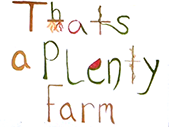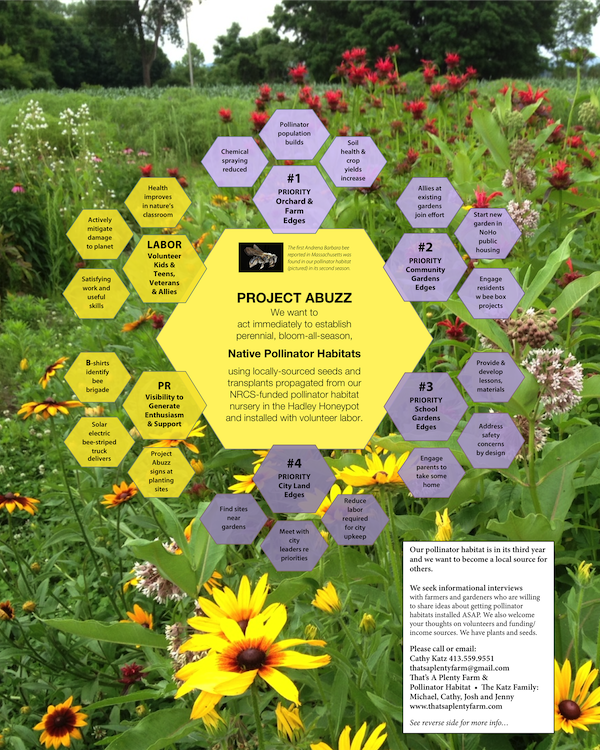Our pollinator habitat is now in its third year, and we are looking for ways to share our plants and seeds to start other habitats. First priority is to find other growers who want to create habitat for native pollinators.
We have created a graphic to explain our goals.
And here’s a description of the project:
That’s A Plenty Farm wants to take action
Now in our 7th farm season, having gotten a good start on establishing a permaculture farm and a pollinator habitat meadow and nursery, with infrastructure that includes 5 unheated greenhouses, we hope to gain some clarity about how to move forward in supporting proliferation of pollinator habitat in the Pioneer Valley. We want to take good advantage of our unique position as the first pollinator habitat in western Massachusetts funded by an EQIP grant from NRCS, to help address the crisis facing pollinators. While not experts in bees ourselves, we are connected with experts and we are committed to helping to support pollinators through this crisis.
As a larger effect, this project will increase biodiversity, generate awareness of a solution that is accessible to many, attract involvement, and perhaps generate income. We need help assessing the realities, and getting more habitats going.
A successful pollinator habitat requires:
- a range of perennial flowering plants that bloom from early spring to the hard frost
- undisturbed habitat to encourage ground-nesting native pollen bees
- plants and conditions supporting the full life cycle of native pollinators
- appropriate natural and constructed nesting shelters for a range of tunnel nesting pollen bees
Plant Sources
We have saved seeds from our habitat, and the nursery plants have matured to the point we can now learn to propagate them. We envision developing collections/trays of mixed plugs, propagating tree starts and distributing them as inexpensively as possible, as quickly as possible, to farms and gardens. [originally sourced from North Creek Nurseries, Applewood Seed Company, Nasami Farm, local growers]
We own this property. That’s a Plenty Farm is three acres of oldfield, high-terrace floodplain forest – 71 feet wide and 1700 feet long – located among hundreds of acres of traditionally-farmed agricultural land.
Labor Sources
Our labor is limited. Currently we have the equivalent of 1.5 full-time people working the farm. In 2015 possible this will be 2.5 people.
Influences
Tom Sullivan, M.A. Conway School (www.pollinatorswelcome.com) – Tom designed the pollinator plant nursery and bee housing
–Tom has engaged Joan Milam, UMASS adjunct faculty member, in capturing and identifying bees on our farm. Last year, Joan caught an Andrena Barbara bee (common in the south, but unexpected this far north), which was formally identified by Dr. John Asher at the Museum of Natural History. This was the first Andrena Barbara identified in Massachusetts.
John Jeavons, Ecology Action, Willits, CA (GrowBiointensive farming training)
Zach Mermel, Conway School of Landscape Design: A view of future possibilities of our entire farm was his student project
Dan Kittredge, Real Foods Campaign, a 10-month class via NOFA (We believe in his philosophy about increasing nutrient density)
Visitors to the habitat have included
Vince Snyder, our funder at NRCS
Gabriela Chavarria, chief scientist for US Fish & Wildlife (formerly of NRDC)
Xerces Society
The Common School (Amherst)
Our Story
Concerned about Climate Change, Cathy and Michael downsized in 2007, purchasing 3 acres of floodplain farm land in the honeypot area of Hadley, for our first farming experience. We have been following protocols to restore the soil according to GrowBiointensive & permaculture principles. We have installed a small solar array (grid-tied). During farm season, we live there in a mobile “tiny house”; we grow 60% of our crops for compost. Infrastructure includes 5 unheated greenhouses. Most of what we have planted is perennial flowers, fruit/nuts and herbs. 50% of our farm is pollinator habitat. Michael, Cathy, and son Josh share the labor of the farm.
- Michael is a composer/jazz piano player/teacher whose music for beginners is widely used in schools throughout the world; his work now is developing an online resource for piano teachers.
- Cathy works full time as director of marketing at inRESONANCE, Inc., a software company in Northampton. Cathy has worked in education for 35 years.
- Josh (our son) is a preschool teacher at The Common School in Amherst; he works part-time on the farm with us.
- Jenny (our daughter) is a freelance communications expert; she does marketing and design for the farm.
See the farm from the air
Google maps has us at about 72 Honeypot Road, Hadley MA – greenhouses and pollinator habitat nursery are visible

